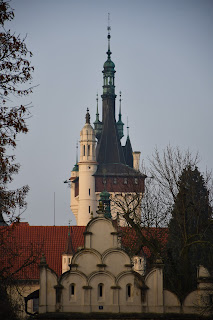Comoros Day 4: Visiting the Coelacanths at the National Museum
With my flight back to Dar Es Salaam scheduled for 13:45, my options for how to spend the morning were limited. However, having found the national museum closed yesterday, I did not have to rack my brains to figure out a programme. The visit took less than half an hour, but I spent another fifteen minutes waiting for the building to open, for although the museum’s official visiting hours begin at eight o’clock in the morning, only the most assiduous employees arrive at that time. I came at around 8:20 myself, when only one of the three ladies who served the ticket booth was present, and she asked me to wait while she turned on some of the electronic information panels.
This is not
to say, by the way, that there were three ladies selling tickets at the ticket
booth, which would have been absurd considering how small the museum is and how
few visitors it probably receives. Rather, the women take turns at serving
customers and spend the rest of their free time keeping each other company. I
believe they are also nominally in charge of selling the souvenirs on display behind
the counter, but seeing how dusty these are, I do not imagine this to be a very
taxing responsibility.
The museum
has two floors. The bottom floor houses a single room with objects from daily
life in the Comoros, while the upper floor is roughly split into four spaces.
The central space, which encircles the staircase just behind the entrance, is
dedicated to the history and architecture of the Comoros. To its left is a
small dark room housing local exemplars of the Qur’an, which separates the
historical section from the geological section on the far left. On the far
right lies the most interesting part of the museum: the biology section. This
is where the museum keeps two giant preserved coelacanths, along with three
smaller preserved coelacanths in the embryonic stage. The Comoros is one of the
very few nations where these prehistoric fish survive, sometimes emerging from
the depths and getting caught in fishermen’s nets. The museum has panels aimed
at the conservation of this species. Explaining that a coelacanth is too fatty
to eat, the boards tell people what to do when they accidentally catch
one.
After
completing this visit, I returned to my hotel to shower and pack my things. I
have become so unused to tropical weather that even walking around the museum
made me sweat profusely, and I could not bear the idea of spending the rest of
the day sitting next to other people while wearing my rank clothes. Then I
checked out. I had 7,750 Comorian Francs left in my wallet, which I judged
should be enough to get me a taxi to the airport as long as I forewent food
until I arrived in Dar Es Salaam. This was probably a good decision, as the sole
driver I found who was willing to take me to the airport would accept no less
than 7,500, explaining that 500 of this sum would go directly to paying the
airport’s parking fees. The remaining 250 was a bi-coloured coin, which I kept
as a souvenir for my dad. It was the only coin I had received as change during
my entire stay.
My driver
was a colourful fellow with opinions on many topics, and he did not let his
feeble grasp of French interfere with his expressing them. For instance, he was
a big fan of Vladimir Putin, claiming that Russia would help kick the French
out of Mayotte. He himself had once used a boat to cross illegally into Mayotte
and spent six months looking for a good job there before giving up and returning
to Ngazidja. His recounting made it sound as though this were a very ordinary
thing many people do, and perhaps that is so: the protagonist of the book I am
currently reading attempts to make the same journey along with two dozen other
people and a goat.
Unmarried,
the driver made no secret of being a great lover of women. I had asked him why
many ladies on the island smear their faces with a whitish paste but could not
make him understand the question. Instead, he began to talk about how beautiful
Comorian women are, especially those of Anjouan, and expressed shock that
during my three days in the Comoros I had not sampled this aspect of the
island. I am not quite sure what he meant with the comment that followed: it was
either a recommendation of a hotel where the female employees are beautiful, or
a recommendation of a hotel where one can procure beautiful women.
The airport
in Ngazidja turned out to be larger than I had assumed having only seen the
arrivals area. It has a proper check-in hall and a big departure hall, which is
built for two gates but appears to use just one of them. During my two-hour
sojourn there, the only shop that accepts visa cards was closed, but the small
café was open and serving customers. I believe that it also provides sustenance
to a local family of birds, who have built their nest in between two ceiling
lights, far out of reach for anybody who might even remotely care about this
problem. Of course, this means that some of the seats in the hall are dotted with
bird faeces, and visitors have to take care when choosing where to wait.
Since
everyone arrived promptly and the passengers coming from Anjouan were waiting
on the plane in sweltering heat, we began the boarding process early and
arrived in Dar Es Salaam almost an hour before our estimated time. The time
saved, however, made very little difference to me. I would still have to wait
at the airport until my Nairobi-bound flight scheduled for half past nine.






Comments
Post a Comment